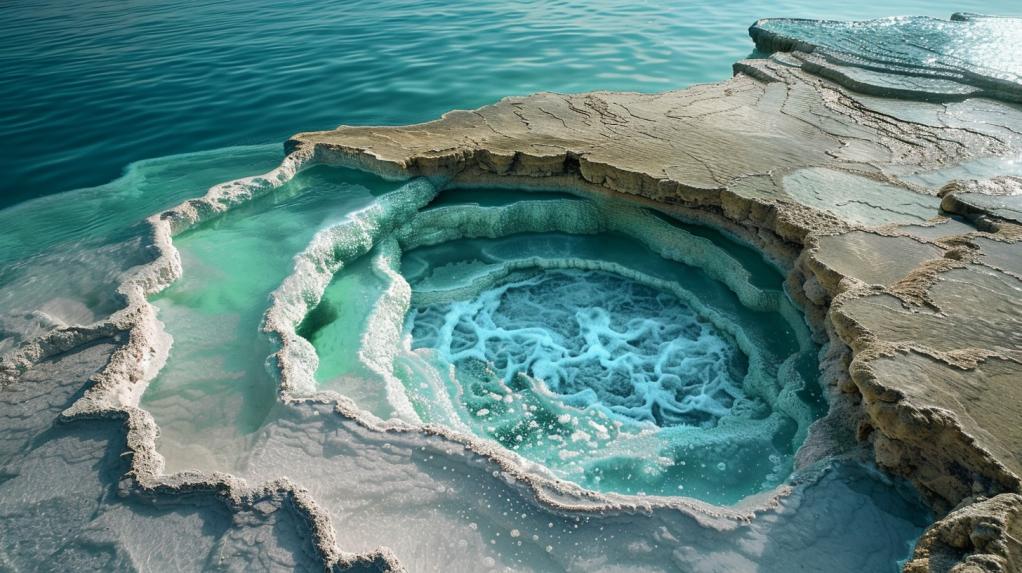Extracting Dead Sea Salt

Embarking on the journey of extracting Dead Sea salt uncovers a fascinating intersection of natural wonder and human ingenuity. Nestled at the lowest point on Earth, the Dead Sea is not only a geographical marvel but also a bountiful source of some of the most mineral-rich salt known to mankind. This salt, coveted for its therapeutic virtues, is harvested through a blend of age-old traditions and modern techniques that respect both the environment and the salt's unique properties. In this article, we'll delve into the art and science behind extracting Dead Sea salt, highlighting the methods that have been refined over centuries and the innovative practices that ensure sustainability for future generations. From the serene shores of the Dead Sea, we invite you on a journey to discover how this precious mineral makes its way from the tranquil depths to enrich our lives, promising not just a glimpse into the process but an appreciation for the delicate balance between nature and human endeavour.
Key Takeaways
- Location: Borders Jordan and Israel, situated at Earth's lowest elevation.
- Environment: Characterised by high evaporation rates and low rainfall, creating ideal conditions for salt concentration.
- Historical extraction: Utilised solar evaporation and hand collection methods.
- Modern extraction: Employs pumps and evaporation ponds while still leveraging natural sunlight.
- Processing & Refinement: Involves cleaning, filtering, and retaining essential minerals during the refinement process.Types of products include those designed for cosmetic use, specifically for skin care.
- Sustainability & Impact: Emphasises protecting the Dead Sea ecosystem through sustainable extraction and production practices.
- Uses: Cosmetic: Dead Sea salts are widely used in skincare products for their mineral-rich properties.
- Marketing: Strategies involve tailored packaging and branding targeted to specific consumer demographics.
- Future & Insights
- The future of Dead Sea salt production is closely tied to ecological conservation efforts.Dead Sea salt embodies a connection to the region's rich history and unique geography.
Extracting Dead Sea salt is an intriguing blend of ancient traditions and modern technology, set against the unique backdrop of the lowest point on Earth. Through sustainable practices, this invaluable resource can continue providing health and beauty benefits well into the future.
The Geography of the Dead Sea
Positioned between Jordan to the east and Israel to the west, the Dead Sea is over 400 meters below sea level, making it the lowest point on Earth's surface. Its extraordinary salt concentration, exceeding 30%, is due to the high evaporation rate and low precipitation. This environment creates the perfect natural setting for the accumulation of salt rich in magnesium, potassium, calcium, and other minerals.
- Location: Bordering Jordan and Israel
- Physical Properties: High salt concentration, extreme buoyancy
- Environmental Contribution: Evaporation, climate conditions
Historical Extraction Methods
Dating back to ancient times, techniques for obtaining Dead Sea salt were simplistic yet effective, primarily involving the collection of salt left behind by evaporative processes. These historical practices laid the foundation for how Dead Sea Salt is still harvested today, maintaining a commitment to the traditional, albeit now complemented by modern advancements to improve efficiency.
- Ancient Techniques: Solar evaporation, manual collection
- Today's Impact: Inspiration for modern methods
Modern Extraction Process
Pre-Extraction Preparation
Before the salt is extracted, a thorough exploration of the area is conducted to evaluate the density of salt and mineral presence. Once rich deposits are identified, the extraction sites are prepared with the necessary equipment and infrastructure to facilitate extraction.
Harvesting Dead Sea Salt
The principal method for collecting salt from the Dead Sea involves the use of evaporation ponds and pumps. The sun-drenched climate is ideal for natural evaporation, which is why solar evaporation plays a significant role in the production process.
- Extraction Techniques: Pumps, evaporation ponds
- Natural Factors: Solar evaporation, arid climate
Separating Minerals from Salt
After collection, the salt undergoes cleaning and filtering to remove impurities while preserving its valuable minerals. This stage is crucial to maintain the therapeutic qualities of the Dead Sea salt.
- Processes: Cleaning, filtering, mineral preservation
- Mineral Importance: Therapeutic and health benefits retention
Environmental Considerations
Extraction processes are carried out with a deep respect for the environment, ensuring sustainable practices that minimize ecological impact and help protect the unique Dead Sea ecosystem.
- Sustainability: Eco-friendly extraction methods
- Protection: Conservation of the Dead Sea habitat
The extraction of Dead Sea Salt is a meticulous process that melds ancient wisdom with modern technology, reflecting the ongoing demand for its therapeutic attributes. With environmental sustainability at the forefront, the future of this industry depends on the continued responsible management and care for this exquisite natural resource.
This vital resource not only enhances lives through its exceptional health and beauty benefits but also signifies a profound connection to the history and geography of this mesmerizing region. With the Dead Sea's resources managed judiciously, future generations can continue to reap the rewards of its storied salt.
Understanding these key points sheds light on the complexity and care involved in bringing Dead Sea salt from its natural, mineral-rich state to the homes of consumers worldwide. It’s important to make environmentally informed decisions and use products that use safe and conservative extraction methods.



